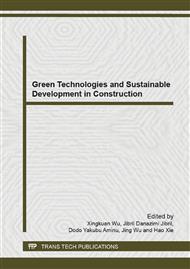p.84
p.88
p.92
p.97
p.102
p.106
p.112
p.118
p.122
Flexible Component for Optimizing Building Performance of the Sustainable School
Abstract:
This study is to achieve a better understanding of the microclimate with architectural component which enhances indoor environment of school buildings. Sophisticated use of transitional space characterized by retractable canopy can affect environmental conditions in ways which lead to have the potential to reduce the energy demand of the buildings in the UK. Computer simulations is adopted to compare heating energy demand in different cities (London, Manchester and Glasgow) with 0%, 50% and 90% transparency of canopies for the fixed type. Result shows flexible type of canopy performs better in terms of indoor energy demand for heating than that of using fixed type of canopy.
Info:
Periodical:
Pages:
102-105
Citation:
Online since:
May 2014
Authors:
Price:
Сopyright:
© 2014 Trans Tech Publications Ltd. All Rights Reserved
Share:
Citation:


